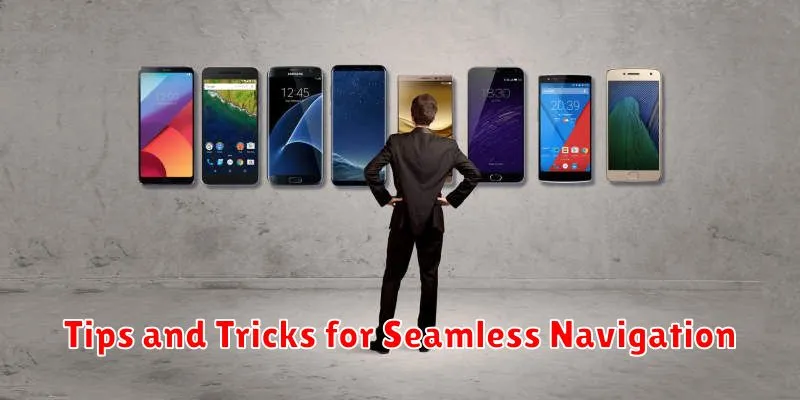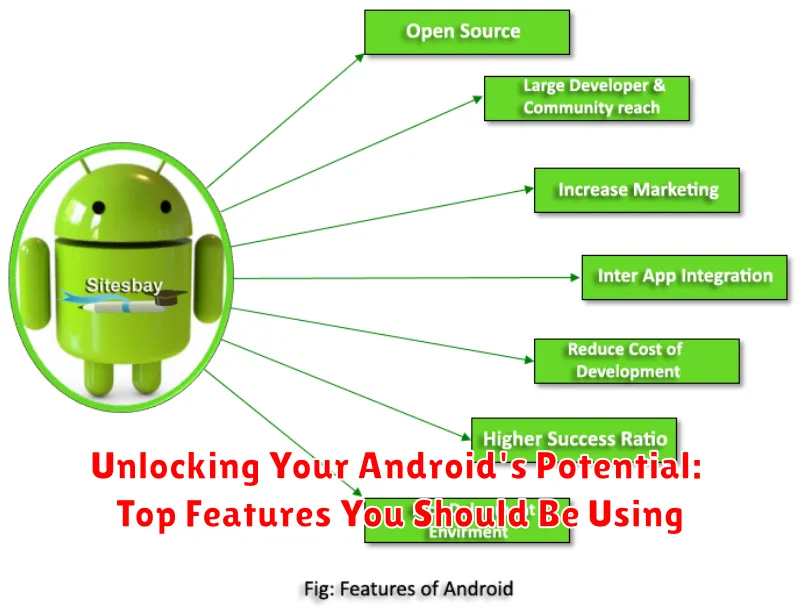Do you truly know the power you hold in your hand? Many Android users only scratch the surface of what their devices can do. This article delves into the top Android features you should be using to unlock your phone’s true potential. From maximizing productivity to enhancing entertainment and bolstering security, we’ll explore how to truly master your Android experience and get the most from your smartphone.
Whether you’re a seasoned tech enthusiast or a casual user, this guide offers valuable insights into essential Android features that can simplify your daily life, improve efficiency, and transform your mobile interactions. Learn how to personalize your Android phone, optimize performance, and leverage the full range of capabilities available at your fingertips. Prepare to unlock a world of possibilities and discover the hidden potential within your Android device.
Essential Android Features for Everyday Use
Android offers a wealth of features designed to simplify daily tasks. Mastering these core functionalities can significantly enhance your user experience.
Notifications and Quick Settings
Notifications keep you updated on important events, while Quick Settings provide instant access to frequently used functions like Wi-Fi, Bluetooth, and screen brightness. Learn to customize these to prioritize what matters most.
Google Assistant
Leverage the power of the Google Assistant for hands-free control. Set reminders, send messages, make calls, and even control smart home devices with simple voice commands.
Default Apps
Personalize your device by selecting your preferred default apps for browsing, email, and other tasks. This creates a seamless workflow tailored to your individual needs.
Accessibility Features
Explore the built-in accessibility features to tailor your device to specific requirements. Options like text-to-speech, magnification, and captions improve usability for everyone.
Boosting Productivity with Built-in Tools
Android offers a suite of built-in tools designed to enhance productivity. Leveraging these features can significantly improve your efficiency and workflow.
Google Assistant: Initiate tasks, set reminders, and send messages hands-free using voice commands. Quickly access information and manage your schedule with this powerful virtual assistant.
Digital Wellbeing: Monitor and manage your app usage with this feature. Set app timers to maintain focus and avoid distractions. Wind Down mode helps prepare for sleep by gradually shifting your screen to grayscale.
Focus Mode: Minimize distractions by temporarily pausing notifications from selected apps. This allows you to concentrate on specific tasks without interruptions.
Clipboard History: Easily access previously copied text and images. This feature can save time when repeatedly entering information.
Nearby Share: Quickly and seamlessly transfer files between nearby Android devices. This eliminates the need for cables or cloud services for local file sharing.
Customizing Your Android Experience
Android offers a wealth of customization options to truly make your device your own. From widgets and launchers to themes and icon packs, you can personalize nearly every aspect of the user interface.
Widgets provide at-a-glance information and functionality directly on your home screen. Explore the available widgets and place those most useful to you for quick access to information like weather, calendar appointments, or music controls.
Launchers allow you to completely overhaul the look and feel of your home screen and app drawer. Experiment with different launchers to find one that suits your organizational preferences and aesthetic tastes. They offer varying levels of customization, from simple icon changes to complex gesture controls.
Consider exploring themes and icon packs for a cohesive visual overhaul. These can dramatically change the appearance of your device, allowing you to express your personal style. Many options are available through the Google Play Store, ranging from minimalist designs to vibrant and colorful themes.
Finally, don’t forget the built-in system settings. You can adjust display settings like font size and screen timeout, configure notification behaviors, and even change system sounds. Taking the time to personalize these settings will significantly improve your overall Android experience.
Enhancing Privacy and Security Settings
Protecting your personal information is crucial in today’s digital landscape. Android offers robust features to bolster your device’s security and safeguard your privacy.
Start by reviewing your app permissions. Limit access to sensitive data like your location, contacts, and microphone, granting permissions only to trusted apps. Navigate to Settings > Privacy > Permission manager to control these settings.
Two-factor authentication (2FA) adds an extra layer of protection to your Google account and other supported apps. Enable 2FA to require a second verification method, such as a code from an authenticator app or SMS, when logging in.
Utilize the Find My Device feature to locate your phone if it’s lost or stolen. You can remotely lock your device, erase its data, or even make it ring. Ensure this feature is enabled in Settings > Security.
Regularly update your Android operating system and apps. These updates often include essential security patches that protect against known vulnerabilities.
Consider utilizing the lock screen features, such as PIN, pattern, or password, to prevent unauthorized access. Biometric options, like fingerprint or facial recognition, offer added convenience and security.
Advanced Features for Power Users
For users seeking to maximize their Android experience, several advanced features offer granular control and enhanced functionality.
Developer Options: Unlocking Developer Options provides access to a range of tools, including USB debugging for connecting to a computer, tweaking animation speeds, and simulating different locations. To enable it, go to Settings > About Phone and tap the Build Number several times.
Screen Recording: Capture on-screen activity with the built-in screen recorder. This tool is ideal for creating tutorials, sharing gameplay, or documenting software issues.
Split Screen Mode: Enhance multitasking by using split screen mode to view and interact with two apps simultaneously. Access this feature through the recent apps menu or by long-pressing the app overview button.
Wireless Debugging: A convenient alternative to USB debugging, wireless debugging allows for connection to a computer over a Wi-Fi network for development and testing purposes. This can be found within the Developer Options.
Hidden Gems: Uncovering Lesser-Known Android Capabilities
Beyond the commonly used features, Android offers a treasure trove of hidden capabilities that can significantly enhance your user experience. Let’s delve into some of these lesser-known gems.
Screen Pinning
Concerned about privacy when handing your phone to someone else? Screen pinning restricts access to a single app. Activate it in Settings > Security, then open the desired app and tap the overview button. The pin icon appears; tap it to lock the screen to that app. This ensures they can’t navigate away from the chosen application.
Nearby Share
Quickly and easily share files with nearby Android devices using Nearby Share. Enable it in the Quick Settings panel and select the file you want to share. Choose the recipient device from the list that appears, and they can accept the transfer seamlessly. This eliminates the need for cumbersome email attachments or messaging apps for quick file exchanges.
Developer Options
Unlock a wealth of customization options with Developer Options. Activate it by tapping the Build Number in Settings > About Phone seven times. Once unlocked, you can adjust animation speeds, limit background processes, and even simulate different locations for app testing. Be cautious though, as modifying certain settings can impact performance.
Tips and Tricks for Seamless Navigation

Mastering navigation on your Android device can significantly enhance your user experience. Here are a few key techniques to streamline your interactions.
Gestures: Utilize Android’s gesture navigation. Swiping up from the bottom of the screen returns you to the home screen. A swipe up and hold reveals recent apps. Swiping from the left or right edge of the screen initiates the “back” function. Practicing these gestures will speed up navigation considerably.
Quick Settings: Access commonly used settings by swiping down from the top of the screen. Customize the Quick Settings panel to include the toggles you use most frequently, such as Wi-Fi, Bluetooth, and Do Not Disturb.
One-Handed Mode: For larger devices, one-handed mode can be a lifesaver. Enable this feature in your device’s settings to temporarily shrink the screen for easier access to all areas with one hand.
Making the Most of Android’s Accessibility Features

Android offers a robust suite of accessibility features designed to make the device usable for everyone, regardless of ability. These features can significantly enhance the user experience, even for those without specific accessibility needs.
Voice Access allows for complete hands-free control of your device. Navigate, open apps, and even type using only your voice. This is particularly helpful for individuals with limited mobility or those who prefer hands-free interaction.
Live Caption automatically generates captions for any audio playing on your device. This includes videos, podcasts, and even phone calls. This feature benefits users with hearing impairments or anyone in a noisy environment.
Select to Speak lets you choose specific text on your screen to be read aloud. This is helpful for individuals with learning disabilities, visual impairments, or anyone who prefers auditory information processing.
Switch Access enables users to interact with their Android device using external switches. This is invaluable for individuals with limited motor skills, enabling them to navigate and control the device with alternative input methods.

